Skived Fin Technology

Crafted out of a single block of metal - whether it be copper, aluminum or some alternative material - skiving is generally used to produce a heatsink with a series of very fine thins that all have the same shape and size. In order to make the right cuts, there are specially designed blades and tools that must be used to ensure fine thin uniformity. In addition, the heatsink manufacturer must use a precise technique to successfully shave the metal out from its initial block. Furthermore, they are closely grouped together in a pattern that inherently optimizes the level of surface area that is achieved, while admitting ample airflow for cooling.
The best applications of this type of heatsink are found in components that house limited space and that exhibit high levels of ventilation. When considering how to optimize surface area it is worth noting that skived find technology provides a more inexpensive way of attaining much the same results as folding and extrusions.
The advantages of this technology are quite apparent; when trying to cut costs it is worth noting that product quality is not sacrificed. In fact, skived fin technology is one of the best ways to enhance thermal conductivity between the heatsink's base and fins. That's because both are carved out from the same material, providing seamless contiguity among the parts. Other heatsink design methods, however, often rely on fixtures between the base and its fins so that spacing is prone to occur and thus cause a greater loss of the heatsink's thermal transfer capability.
For Your Next Project, Contact CoolianceToday!
High reliability thermal solutions & precision metal products.
